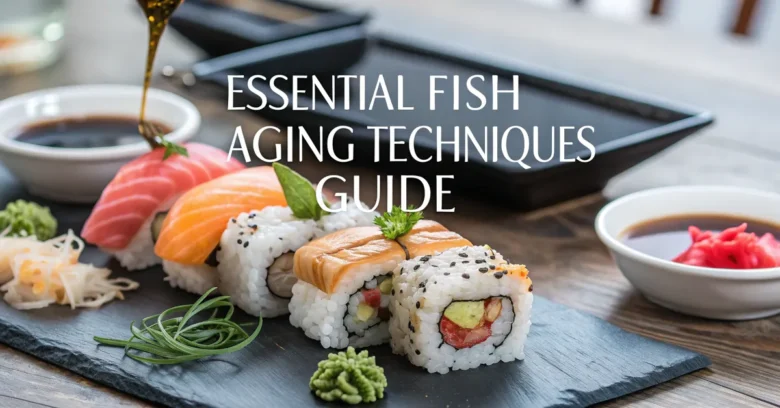Is aging fish just letting it rot? Not quite! As a home sushi chef, you strive for perfection. You want that melt-in-your-mouth texture and umami depth that only comes with properly aged fish. But how do you achieve that restaurant-quality result at home?
This guide cuts through the mystery surrounding fish aging. Forget vague instructions and dive into proven techniques. You’ll discover the secrets to safely transforming ordinary fish into a culinary masterpiece. We’ll explore different methods, offering you the knowledge to confidently age fish and elevate your sushi game to new heights.
Essential Fish Aging Techniques Guide
Why Age Fish? The Science of Better Sushi
Think of aging fish like aging a fine wine or a perfectly marbled steak. It’s a controlled decomposition process that brings about a symphony of desirable changes. But what exactly happens on a microscopic level?
- Umami Boost: Fresh fish contains inosinic acid, a precursor to umami. Over time, enzymes break down proteins into free amino acids, including glutamate, a key component of umami. This intensifies the savory flavor, creating a more complex and satisfying taste experience.
- Tender Texture: Rigor mortis, the stiffening of muscles after death, makes freshly caught fish tough. Aging allows enzymes to break down muscle fibers, resulting in a more tender and pleasing texture.
- Moisture Control: Aging, especially dry aging, allows some surface moisture to evaporate, concentrating the flavors and further enhancing the texture.
Simply put, aging unlocks the fish’s full potential, transforming it from a simple ingredient into a delicacy. But remember, safety is paramount. Improper aging can lead to spoilage and foodborne illness. This guide will equip you with the knowledge to age fish safely and effectively.
Understanding the Key Players: Fish, Enzymes, and Bacteria
Before diving into the techniques, let’s meet the key players in the fish aging process.
- The Fish: The type of fish you choose dramatically affects the aging process. Fatty fish like salmon, tuna, and mackerel benefit most from aging due to their higher fat content and robust flavor profiles. Leaner fish, such as snapper or sea bass, can also be aged, but the results might be less pronounced.
- Enzymes: These natural catalysts within the fish are responsible for breaking down proteins and fats. Their activity is influenced by temperature, humidity, and salt concentration, which is why precise control is crucial for successful aging.
- Bacteria: While we aim to control enzymatic activity, we must also be vigilant about preventing harmful bacterial growth. This is where proper sanitation, temperature control, and the use of salt or other preservatives come into play.
Understanding how these elements interact is the key to mastering fish aging. It is worth noting that the species, fat content, and freshness of fish can affect the aging process and the final result. It is also very important to use fish that is sushi grade. Sushi grade refers to fish that is fresh enough and has been handled properly to minimize the risk of food poisoning.
Essential Equipment for Fish Aging at Home
You don’t need a professional kitchen to age fish successfully. However, some essential equipment will ensure consistent and safe results.
- Refrigerator with Precise Temperature Control: Maintaining a consistent temperature between 32°F (0°C) and 38°F (3°C) is critical for slowing bacterial growth and controlling enzymatic activity. A dedicated refrigerator is ideal, but a well-controlled main refrigerator can also work.
- Vacuum Sealer: This is a crucial tool for many aging techniques. It removes air, preventing oxidation and slowing bacterial growth.
- pH Meter: This device allows you to measure the acidity of the fish, providing insight into the aging process and safety. A pH of 6.0 or below generally inhibits the growth of most harmful bacteria.
- Digital Scale: For precise salt measurements in curing techniques.
- Food-Safe Containers: For storing and aging fish.
- Boning Knife: To remove pin bones and to fillet fish.
Having these tools will help you confidently execute the following fish aging techniques and create delicious sushi.
Fish Aging Techniques: A Step-by-Step Guide
Here’s an in-depth look at several fish aging techniques you can try at home.
1. Dry Aging: Concentrating Flavors and Textures
Dry aging involves exposing the fish to controlled temperature and humidity, allowing surface moisture to evaporate and enzymes to break down muscle fibers.
- Suitable Fish: Fatty fish like tuna, salmon, and mackerel.
-
Process:
-
Prepare the Fish: Pat the fish dry with paper towels. Ensure the fish is sushi grade.
-
Wrap the Fish: Wrap the fish with specialized dry aging membrane.
-
Refrigerate: Place the wrapped fish on a wire rack in your refrigerator.
-
Monitor Temperature: Maintain a temperature between 32°F (0°C) and 38°F (3°C).
-
Aging Time: Aging can last from 3 to 14 days, depending on the desired level of flavor and texture. Start with a shorter duration for your first attempt.
-
-
Tips:
- A dedicated refrigerator is ideal for dry aging to avoid cross-contamination and maintain a consistent temperature.
- Monitor the fish daily for any signs of spoilage (unpleasant odor, slimy texture).
- Dry-aged fish will develop a slightly firm, dry outer layer. This layer can be trimmed before serving.
2. Wet Aging: Enhancing Tenderness and Umami
Wet aging involves storing the fish in a vacuum-sealed bag, allowing enzymes to work without moisture loss.
- Suitable Fish: Tuna, salmon, yellowtail, and other firm-fleshed fish.
-
Process:
-
Prepare the Fish: Pat the fish dry with paper towels.
-
Vacuum Seal: Place the fish in a vacuum-seal bag and remove all air.
-
Refrigerate: Store the vacuum-sealed fish in your refrigerator.
-
Monitor Temperature: Maintain a temperature between 32°F (0°C) and 38°F (3°C).
-
Aging Time: Wet aging can last from 3 to 7 days, depending on the fish and desired results.
-
-
Tips:
- Ensure the vacuum seal is airtight to prevent bacterial growth.
- Monitor the fish for any signs of spoilage (unpleasant odor, gas accumulation in the bag).
3. Salt Aging (Shiozuke): Preserving and Flavoring
Salt aging, or shiozuke, involves curing the fish with salt, which draws out moisture and inhibits bacterial growth while enhancing flavor.
- Suitable Fish: Mackerel, salmon, sea bass, and other fish with firm flesh.
-
Process:
-
Prepare the Fish: Fillet the fish and remove any pin bones.
-
Salt Application: Generously cover the fish with salt. The amount of salt depends on the size and type of fish, but a general guideline is 3-5% of the fish’s weight.
-
Wrap and Refrigerate: Wrap the salted fish in cheesecloth or paper towels and place it in a container. Store it in your refrigerator.
-
Aging Time: Salt aging can last from 1 to 7 days, depending on the desired level of preservation and flavor.
-
Rinse and Dry: Before serving, rinse the fish thoroughly to remove excess salt and pat it dry.
-
-
Tips:
- Use high-quality sea salt for the best flavor.
- Adjust the amount of salt and aging time based on your taste preferences.
- Salt-aged fish will have a firmer texture and a more intense flavor.
4. Kombu Curing (Kombujime): Infusing Umami and Aroma
Kombujime involves wrapping the fish in kombu seaweed, which imparts umami and a delicate aroma while also drawing out moisture.
- Suitable Fish: Sea bream (tai), flounder (hirame), and other white fish.
-
Process:
-
Prepare the Fish: Fillet the fish and remove any pin bones. Lightly salt the fish and let it rest in the refrigerator for 30 minutes.
-
Prepare the Kombu: Lightly dampen the kombu sheets with sake or water.
-
Wrap the Fish: Place the fish between two sheets of kombu.
-
Refrigerate: Wrap the kombu-wrapped fish in plastic wrap and store it in your refrigerator.
-
Aging Time: Kombujime can last from 1 to 3 days, depending on the desired level of flavor infusion.
-
Prepare to Serve: Before serving, remove the kombu and gently wipe the fish.
-
-
Tips:
- Use high-quality kombu seaweed for the best flavor and aroma.
- The kombu can be reused several times.
- Kombujime fish will have a subtle sweetness and a delicate umami flavor.
5. Lactic Acid Fermentation: An Advanced Technique
Lactic acid fermentation is a more complex technique that involves creating an environment where lactic acid bacteria can thrive, inhibiting the growth of spoilage organisms. This method requires a precise understanding of microbiology and is not recommended for beginners.
- Suitable Fish: Fatty fish like salmon and tuna.
-
Process: (This is a simplified overview; detailed instructions require specialized knowledge.)
-
Prepare a Starter Culture: Create a starter culture of lactic acid bacteria.
-
Inoculate the Fish: Inoculate the fish with the starter culture.
-
Vacuum Seal: Vacuum-seal the fish.
-
Ferment: Ferment the fish at a controlled temperature (typically between 60°F and 70°F) for a specific period, monitoring the pH level.
-
Refrigerate: Once the desired pH is reached, refrigerate the fish.
-
-
Tips:
- This technique requires strict hygiene and temperature control to prevent the growth of harmful bacteria.
- Use a pH meter to monitor the fermentation process and ensure safety.
- Lactic acid-fermented fish will have a tangy, slightly sour flavor.
Mastering the Art: Tips for Consistent Results
- Start with High-Quality Fish: The fresher and higher quality the fish, the better the final product will be. Look for sushi-grade fish from reputable sources.
- Temperature is Key: Precise temperature control is crucial for slowing bacterial growth and controlling enzymatic activity.
- Hygiene is Paramount: Practice strict hygiene to prevent the growth of harmful bacteria. Sanitize all equipment and work surfaces thoroughly.
- Trust Your Senses: Monitor the fish daily for any signs of spoilage (unpleasant odor, slimy texture, discoloration). If you notice any of these signs, discard the fish immediately.
- Document Your Results: Keep detailed notes on each aging experiment, including the type of fish, aging time, temperature, and your sensory evaluation. This will help you refine your technique and achieve consistent results.
- Experiment and Refine: Fish aging is an art as much as a science. Don’t be afraid to experiment with different techniques and aging times to find what works best for your palate.
How Long to Age? A Matter of Taste
The ideal aging time depends on several factors, including the type of fish, the aging technique, and your personal preferences.
- Start Short: For your first attempt, start with a shorter aging time (e.g., 3 days for wet aging, 1 day for kombujime). You can always age the fish longer if desired.
- Trust Your Senses: The best way to determine when the fish is ready is to rely on your senses. Look for a firm, slightly dry texture, a pleasant aroma, and a vibrant color.
- Experiment and Refine: Keep detailed notes on each aging experiment, including the aging time and your sensory evaluation. This will help you refine your technique and achieve consistent results.
Common Pitfalls and How to Avoid Them
- Spoilage: This is the most common pitfall of fish aging. To avoid spoilage, practice strict hygiene, maintain precise temperature control, and monitor the fish daily for any signs of spoilage.
- Over-Aging: Over-aging can result in a mushy texture and an unpleasant flavor. To avoid over-aging, start with a shorter aging time and monitor the fish closely.
- Uneven Aging: Uneven aging can occur if the fish is not properly prepared or if the temperature is not consistent. To avoid uneven aging, ensure the fish is properly trimmed and that your refrigerator maintains a consistent temperature.
Serving and Enjoying Your Aged Fish
Once you’ve successfully aged your fish, it’s time to savor the results.
- Sushi and Sashimi: Aged fish is perfect for sushi and sashimi, where its enhanced flavor and texture can truly shine.
- Other Preparations: Aged fish can also be grilled, pan-fried, or used in other culinary applications.
- Pairings: Consider pairing your aged fish with complementary flavors, such as soy sauce, wasabi, ginger, or citrus.
Is Aging Fish Safe? The Critical Role of Food Safety
Aging fish involves inherent risks, and food safety must be your top priority. Here are critical considerations:
- Source High-Quality Fish: Start with sushi-grade fish from a reputable supplier who follows strict handling and storage protocols.
- Maintain Cold Temperatures: Keep the fish at or below 40°F (4°C) at all times to inhibit bacterial growth.
- Prevent Cross-Contamination: Use clean cutting boards and utensils. Wash hands thoroughly after handling raw fish.
- Limit Aging Time: Do not exceed recommended aging times, as spoilage risk increases exponentially.
- Trust Your Senses: Discard any fish that has an off odor, slimy texture, or discoloration.
- When in Doubt, Throw It Out: It’s better to be safe than sorry. If you suspect spoilage, discard the fish immediately.
It is very important to note that pregnant women, young children, the elderly, and people with weakened immune systems should not consume aged fish. It is also recommended to consult with a food safety expert to learn more about the risks involved.
Beyond the Basics: Experimenting with Flavors
Once you’ve mastered the basic aging techniques, you can start experimenting with flavors to create unique and exciting sushi experiences.
- Infused Salts: Use infused salts (e.g., smoked salt, citrus salt, herb salt) to cure the fish.
- Aromatic Wraps: Wrap the fish in aromatic herbs (e.g., rosemary, thyme, shiso leaves) during aging.
- Marinades: Marinate the fish in sake, soy sauce, or other flavorful liquids before aging.
The possibilities are endless. Let your creativity guide you and discover new and exciting flavor combinations.
Aging Fish: A Commitment to Craft and Flavor
Aging fish is an art that requires patience, precision, and a commitment to food safety. But the rewards are well worth the effort. By mastering these techniques, you can unlock the full potential of fish and create sushi experiences that are truly exceptional. So, embrace the challenge, experiment with confidence, and elevate your home sushi game to new heights.
Are you ready to start experimenting and experience the magic of aged fish for yourself?



